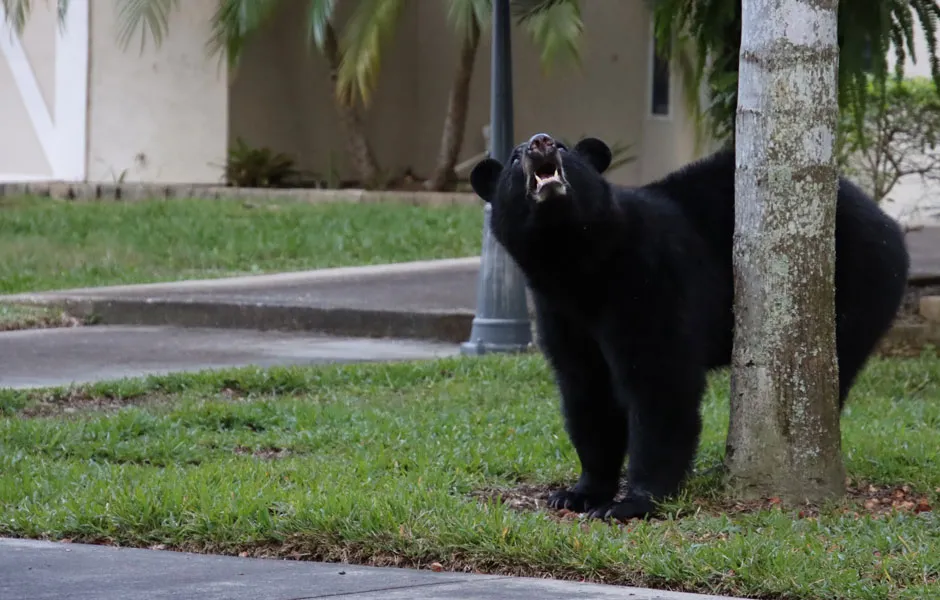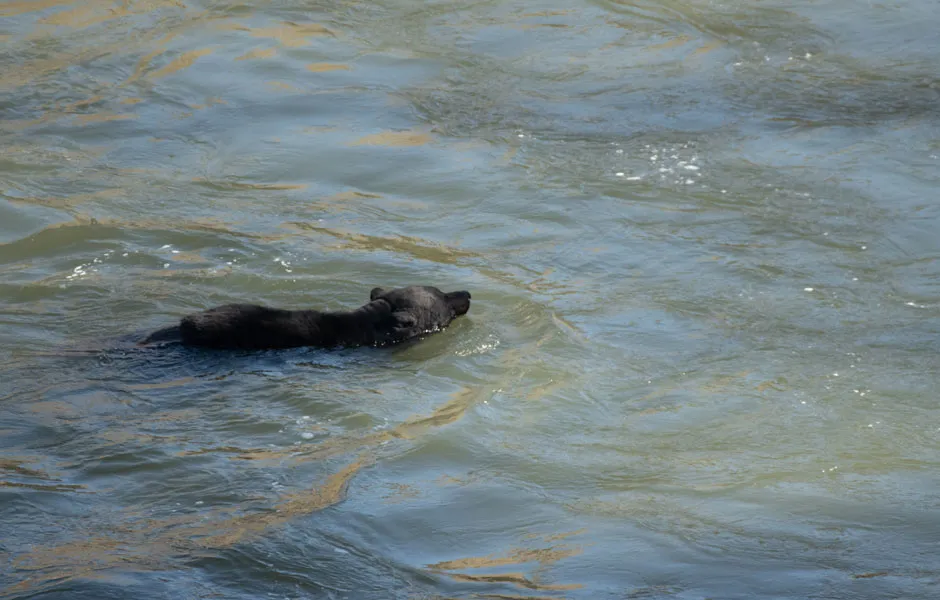At first, the bears went unseen in the nighttime, like mischievous elves descending from the woods. But instead of mending shoes or spinning straw into gold, they cracked compost bins, tore open beehives, and licked small traces of beef tallow from backyard grills, only to disappear with the first hint of the rising sun.
Bungtowners [residents of Burlingham, Ohio] watched uneasily as a series of raids in a century-old barn reduced a feral colony of hardy barn cats from a population of 20 to nought.
People also began reporting other incidents that didn’t quite gibe with how a bear ought to behave. One night in Bungtown, a Vietnam veteran named Dave Thurber, feeling uneasy, tweaked his living room curtain and saw a bear lumbering across his front yard, leaving deep claw marks in the snow.
Right off the bat, this was a bit unnatural. During a New England winter, a bear—or to be more precise, a normal bear—is in the middle of a season-long slumber. For five or more months, the bear lies in a den, its heart rate lowered to a somnambulant eight beats per minute; it does not eat, drink, defecate, or urinate until the warmth of spring signals the promise of new vegetation to eat.
But this bear was far from unconscious. It walked to a tall metal post where Thurber’s calorie-laden bird feeder perched out of reach. Making short work of the post, the bear easily brought the payload of seeds earthward, then cracked open the feeder’s plastic hull.
Read more about bears:
As the bear began to eat, a car bumped up the rutted dirt road, high beams sliding across the lawn like prison searchlights scanning a jail yard for escaping convicts. And indeed, Thurber saw that the bear acted like a convict, deftly avoiding the light streams by flattening itself just beyond their reach, in the shadowed lee of a large snowbank.
As soon as the lights swept on, the bear reclaimed the bird feeder, delicately licked up the remaining seeds, and walked toward the nearest neighbour—perhaps the cat barn—to see what might be on offer there.
Thurber’s experience with the bear was surprising, because the bear wasn’t simply seeking cover when humans approached. Rather, it seemed to be specifically avoiding the light.
Which suggested that the bear knew human passersby could only see where the light struck.
Which further suggested that the bear had the mental capacity to understand the physical properties of his surroundings, as they would appear to a human, and act accordingly – and under our common human understanding of animal intelligence, that would make this particular animal some sort of bear genius.

In a sense, evolution grants every living thing a brilliant talent for squeezing life from its surroundings—the more extreme the habitat, the greater the savant.
Frogs, for example: The panamanian golden frog, which cannot make itself heard above the roaring waterfalls of Panama, attracts mates through the use of semaphore. New England’s Eastern Gray Tree Frog, on the other hand, can survive being frozen nearly solid; all winter its organs sit like tiny hunks of beef jerky in an icy slurry of body fluids.
But these sorts of biological precocity are the domain of specialists. Against this backdrop, some living things exhibit an even greater level of genius, having evolved the grey matter needed to unlock a wide array of habitats. Humans are one of these problem-solving species. Bears are another.
Read more about bears:
Bears have so many physical gifts that it’s hard to imagine why they would need to problem-solve at all. Their large, padded feet carry them over swampland like rugged boots; each boot terminates in five blunt, pocketknife-sized claws that can tear open stumps and burrows or climb trees to access beechnuts on the branch.
With their enormous strength (they can bend a car door in half) and size (hunters have killed quarter-ton black bears in New Hampshire; the national weight record is 402kg), they can prey opportunistically on a wide variety of smaller creatures, including young deer and moose.
Outside of human hunters, the only things that eat bears are larger bears (though researchers are at a loss to fully understand the reasons behind black bear cannibalism).
Bears have sharper eyesight than people (with night vision to boot), ears that are twice as sensitive, and noses capable of scenting a carcass twenty miles distant (seven times better than a bloodhound).
If escaping a bear’s notice is unlikely, so is escaping the bear itself. Humans can dive into water to flee cougars, climb trees to evade raging rhinoceri, and outrun alligators. But the average black bear swims speedily and climbs quickly. It could spot Usain Bolt 25 meters in his world-record-setting 100-meter dash and still pounce on the world’s fastest man well before the finish line.

To be clear, bear attacks are very rare. From a statistical standpoint, you’re more likely to suffocate in a giant vat of corn than be injured by a bear.
But modern attacks do happen, with seriously not-good outcomes.
Cynthia Dusel-Bacon, by all accounts a rugged 31-year-old geologist, was conducting a land survey in the Alaskan bush in 1977 when she saw an aggressive black bear beelining toward her. Dusel-Bacon waved her arms and shouted, right up until the moment the bear knocked her down, after which she decided to play dead so the bear wouldn’t see her as a threat.
That was a consequential error in judgment, experts said afterward, because the 77kg bear likely never saw her as a threat. It was just hungry.
When she stopped resisting, it dragged her into the trees and began to eat her alive. Even as some parts of her body disappeared down the throat of the bear, other parts of her body, quite heroically, accessed a communication device and alerted a partner in the area as to her emergency.
Other geologists arrived in a helicopter and scared the bear off in time to save her life. The never-say-die Dusel-Bacon went on to post instructional YouTube videos in which she demonstrates how to chop carrots, wash dishes, and get dressed with two prosthetic arms.
For the residents of Grafton, whose homes were being probed with frightening regularity by a resurgent bear population, ursine intelligence levels were a key factor in a question most people never have to ask: how close am I to a bear right now?
After all, it’s one thing to be appropriately respectful of a creature’s brute force. It’s quite another to live alongside one sly enough to case your home with the cool calculation of a professional burglar.
Graftonites weren’t the first ones to concern themselves with bear IQs. Those who suspected high-level thinking in Grafton’s bears had a rogue scientist champion – Ben Kilham, one of the foremost bear experts in the world.
Kilham (featured as the “bear whisperer” in a panda bear documentary narrated by actress Kristen Bell) employs many of the controversial methods employed, famously, by the primatologist Jane Goodall.
He names the bears he studies, attributes emotional motivations to their behaviour, and probably wouldn’t have to work too hard to get a nod from Guinness as the world record–holder for enduring the highest number of nonfatal bear bites.
When Kilham is not living in the woods alongside wild bears, he sleeps in his human home, which is not 4km from Grafton.
Many Graftonites, including John Babiarz, referred me to Kilham, and so I called to find out whether bears are indeed smart enough to avoid the light of a passing car, surveil farmsteads, snatch cats, and do many of the other things reported in Grafton that struck me as improbable.
Kilham (who also happens to be a former gun designer) answered a few of my questions and then said that, if I really wanted to learn more about bear psychology, I should buy a book that gets into the nuances. He recommended one in particular, titled In the Company of Bears, available in paperback from Amazon. The book was written by Ben Kilham.
Kilham has seen more of the inner workings of bear life than anyone. In the book, his vivid description of their intricate society suggests that bears are even smarter than sign language–savvy apes.
Kilham credits bears with self-awareness, the ability to count to twelve (primates can only manage a three-count), and cooperation to enforce a bear justice system. He says they can remember the distant past, mull over the likelihood of events in the distant future, and communicate and empathize with one another. One resource-strapped female bear can even, he says, engage in the incredibly complex negotiation of asking another, better-off female to adopt her cub.
After reading Kilham’s books and other research, I was thoroughly convinced that bears are smart enough to employ high-level reasoning in their efforts to plunder calories from humans. But brains alone didn’t explain some of the behaviours I was hearing about.
Extracted from A Libertarian Walks Into a Bear: The Utopian Plot to Liberate an American Town (£22.99, PublicAffairs) by Matthew Hongoltz-Hetling.
- Buy now from Amazon UK, Bookshop.org and Waterstones